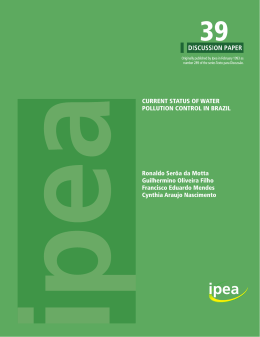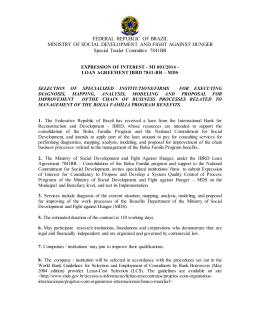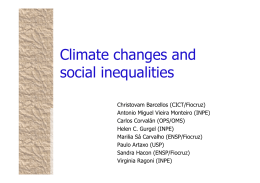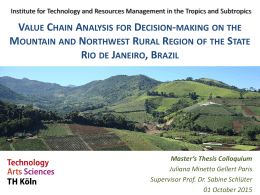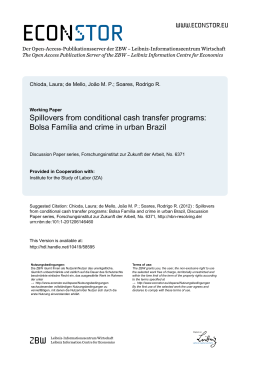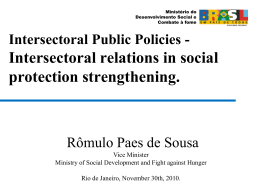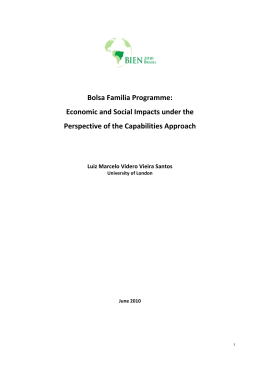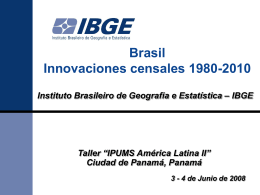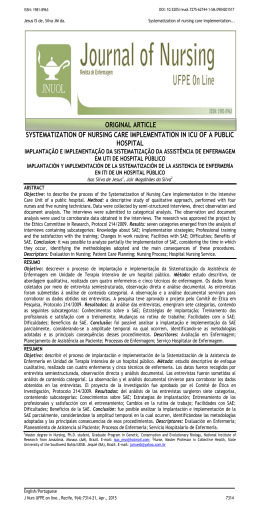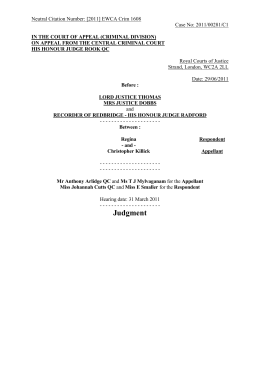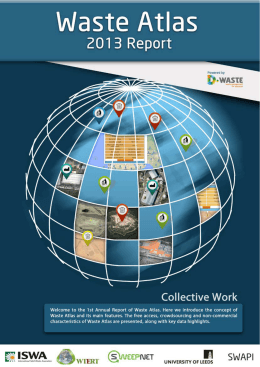Innovations for Poverty Alleviation and Social Mobility Marcelo Neri Strategic Affairs (SAE/PR) and EPGE/FGV CEDLA – University of Amsterdam Brazil as Innovator November, 2014 Poverty Alleviation and Social Mobility • Broadview on Brazilian Progress: The Middle Path • Track Record from Household Surveys (also Recent Changes) and Its Causes - Prosperity & Equity - Sustainability (productivity, education & risk) - Sensibility (perceptions & protests) • Public Policies Challenges and Lessons Learned: - Broader Prospective Agenda - Bolsa Família 3.0 % Population with Income Below U$ 1.25 per day PPP Brazilian Per Capita GDP (PPP) was 93.7% of the World GDP in 2012 Brazilian Per capita GDP PPP has grown 3.5% against 3.6% of the world between 2002 e 2012 Brazil: Middle of the World Source: IPEA / SAE from PNUD % Population with Income Below U$ 1.25 per day PPP A World within Brazil Source: SAE from the Demographic Census/IBGE What explains + Social Inclusion? Statistical stability last year Growth or + Equity? 2001-2013 But 50% faster than MDG in last 2 years 1st MDG: Extreme Poverty Line (U$S 1,25 a day PPP) fell 56% in 12 years Component that Explains Income growth Brazil Main Target Proportion of Extremelly Poor % of Total Fall (56%) 46,7% The Middle Path Inequality Fall 53,3% Total 100% Source: IPEA/SAE from PNAD/IBGE microdata Changes in Income Distribution 2001 -2013 Cumulative Growth Rate of Per Capita Income by Vintiles 2001-2013(%) 120% 113% 115% 112% Income of the 5% poorest has grown 415% faster than the 5% richest 106% 104% 97% Cumulative Growth (%) 100% 94% 92% 87% 84% 82% 80% 73% 69% 63% 60% 58% 52% 47% 39% 40% 33% 27% 20% 0% 1 2 3 4 5 6 5% poorest Soucre: IPEA/SAE from PNAD/IBGE microdata 7 8 9 10 11 12 13 14 15 Vintiles of Household Income - per capita 16 17 18 19 20 5% richest Shared Prosperity (2001-13) (Mean and 40% Poorest) Determinants of the Gains in Real Per Capita Prosperity from 2001 and 2013 in annual percentage points 0,07 e 0,82 Other 3,26 e 5,80 Total Effect Includes Bolsa Família Labor 2,47 e 3,86 0,76 e 1,16 Social Security & BPC 0,20 e -0,39 Quantity = Participation Rate + Unemployment + Hours 0,54 e 1,05 Value of Education Wages and Profits 1,73 e 3,21 Educational Bonus Horizontal Inequality - Growth Rate Excluded Groups Income Annual Growth Rate of Per Capita Household Income - 2001 to 2013 6.9% 7% 5.7% 6% 5.0% 5% 4.7% 4.8% 4.5% 3.8% 4% 3.7% 3.3% 3% 2% 1% 0% Total Northeast Source: SAE from PNAD/IBGE microdata Rural 10 or + 0 to 6 years Residents of Age Blacks Head- 0 Years of Schooling HeadDomestic Servant HeadInformal Worker Inequality Within Municipalities Gini Index of Per Capita Income by Municipality - 2000 2000 Source: Demographic Census/IBGE microdata Inequality Within Municipalities Gini Index of Per Capita Income by Municipality - 2010 In the 2000s Inequality fell in 83,3% of LACs and in 39,2% of other 91 world countries 2010 Inequality fell in 80% of the 5500 Brazilian Municipalities Source: Demographic Census/IBGE microdata Latin America Latina last 3 Decades Long Run Perspective Inequality of Per Capita Income (Gini) 62 0.607 6 0.592 0.589 0.581 Inequality (Gini) 0,58 0,56 0,54 0.560 0.543 0.535 Falling inequality in Brazil but still the 18th highest in 155 countries 0.523 0,52 0,5 0,48 1960 1970 1979 1990 2001 2007 Year Source: CPS;FGV from PNAD, PME and Census / IBGE microdata and Langoni (1973) 2009 2013 Is Inequality Still Falling ? And in Latin America? Brazilian Gini is now stable? 2011 2012 2013 0,5272 0,5243# 0,5229# Cornia (2014) on CEDLAS & CEPAL data for 11 countries with complete data for 2008-12, i.e.: Argentina, Bolivia, Brazil, Colombia, CostaRica, Ecuador, El Salvador, Mexico, Panama, Peru and Uruguay. The dotted line includes Uruguay (which recorded a higher-than-average Gini drop over 2008-12. The solid lines excludes it. Source: PNAD/IBGE microdata # Not a statistically significant change with respect to 2011 Income Inequality Has labor income inequality stopped falling? GINI of Per Capita Labor Income* Inequality Index, March 2002 to July 2014 (October 2014) 0.64 0.62 0.60 0.58 Between 2011 and 2013 had a slower pace but reaccelerates after 0.56 0.54 2002 (Mar.) 2003 2004 2005 2006 2007 2008 October 14 - 0,5442 2009 2010 2011 Source: IPEA/SAE from PME/IBGE (2002-2014) microdata *the table only covers SP, RJ, BH and Recife *Per Capita Household Labor Income - 15 to 65 Years 2012 2013 2014 (Jun.) How much did it grow? Prosperity Equality GDP X Mean Income PNAD X Median Income PNAD X 10% Ritchest Real Per Capita 2003 = 100 200 180 186.8 Real differences are explained by the use of different deflators, in nominal terms mean growth rates are similar. Same Story in 2013. 178.4 160 151.7 140 136.0 127.8 120 100 2003 2004 2005 2006 2007 Source: SAE from PNAD/IBGE microdata and National Accounting/IBGE 2008 2009 2010 2011 2012 157.0 140.0 129.6 2013 Ranking Latin America Annual Growth 2003-12 Per Capita HH Income 1 Argentina 5,50% 20% 60% 40% a 2 Colombia 4,68% a a 20% + TOTAL 60% 3 Brasil 4,60% 40 % 80% 4 Perú 4,56% 5 Uruguay 4,42% 4,41 4,44 3,94 3,11 3,48 6 Bolivia* 3,96% 7 Ecuador 3,79% 8 Panamá 2,77% 9,11 8,35 7,16 7,26 7,66 9 Paraguay 2,74% 10 Costa Rica 2,72% 11 Chile* 2,48% 6,73 6,38 5,54 5,17 5,55 12 México 1,08% 13 El Salvador 1,03% 14 Hondura 0,94% 5,77 5,06 3,96 2,36 3,3 Rep. 15 Dominicana -0,87% 16 Nicaragua* -1,52% 17 Guatemala* -1,84% The New Decade – HH Per Capita Income Growth by Quintiles 20% - 20122013 1,37 20112012 11,6 20112013 6,37 20012013 6,41 Source: PNAD/IBGE microdata Source: CEDLAS microdata Growth 2010 • 2013 • 2014 Cunnulative Growth Rate by Percentiles – Quantile Regression 20% 17.8% 14.7% 15% 13.7% 12.0% 9.0% 10% 8.0% 5% 0% 5% 15% 25% 35% 45% 55% 65% 75% Source: IPEA/SAE from PME/IBGE (2002-2014) microdata *the table only covers SP, RJ, BH and Recife *Per Capita Household Labor Income - 15 to 65 Years 85% 95% Source: SAE from PME/IBGE microdata (2002-2014) *Per Capita Household Labor Income – 15 to 65 Years No Income Imputation Aug- 14 October14 May - 14 Jan - 14 Sep - 13 3,64% 3.88% Median 6.43% 6.80% 6.95% 7.27% 6.80% 6.1% 5.7% 5.05% 4.35% 4.65% 4,26% 3.61% 3.03% 2.28% 1.92% 4.7% 4.31% 3.63% 3.41% 3.13% 2.42% 1.83% 1.28% 0.88% 3.43% Mean May - 13 Aug- 14 October14 Jan - 13 May - 14 Jan - 14 Sep - 13 May - 13 -0.54% Jan - 13 Real Per Capita Income Growth 12 months PME Will November 2014 be “Dilma’s Real”? Idiossincratic Risk of Per Capita Labor Income Risk of Falling X Opportunity to Rise Across the Median The risk of crossing the median in an upward direction has never been so high: 27% of the people who were below the median crossed it in 2012/2013 – inversion of the risks of falling/rising 10 years later 27.13 26.34 24.86 13.19 13.31 2008/ 2009 13.79 2007/ 2008 13.57 13.71 19.45 13.69 2005/ 2006 20.12 17.79 2004/ 2005 12.73 16.80 16.42 2003/ 2004 15 17.58 17.03 18.81 2002/ 2003 20 14.41 16.01 25 23.10 26.24 30 2010/ 2011 2011/ 2012 2012/ 2013 10 5 2006/ 2007 Source: IPEA/SAE from PME/IBGE longitudinal microdata 2009/ 2010 New Middle Class: Evolution of Economic Classes Pyramid 2003 - 2013 Classes A to E AB Classes INCREASED 12.5 Mi 20.7 Mil 26.3 Mil 13.8 Mil Classes AB 67.8 Mil Classe C 97.8 Mil C Class INCREASED 44.7 Mi 98.8 Mil 62 Mil 75 Mil Classes DE 2003 Fonte: CPS/FGV e SAE/PR a partir dos microdados da PNAD/IBGE 2009 112.5 Mil 2013 More 4,3 mi in ABC classes in 2013 and plus 10 mi in 2012 and 2014 Evolution of ABC Classes AB = Traditional Middle Class; C = New Middle Class Log (share of middle class)= 16.9 - 3.2 Log(alienation) R2=0.97 (28.5) (-23.3) 1993 2013 has the Lowest Alienation and Polarization levels in PNAD series 1995 2014 (forecast) % Classe ABC 1993 13.01 - 28.32 28.32 - 43.63 43.63 - 58.93 58.93 - 74.24 74.24 - 89.55 % Classe ABC 1995 13.01 - 28.32 28.32 - 43.63 43.63 - 58.93 58.93 - 74.24 74.24 - 89.55 2003 % Classe ABC 2003 13.01 - 28.32 28.32 - 43.63 43.63 - 58.93 58.93 - 74.24 74.24 - 89.55 2009 % Classe ABC 2009 13.01 - 28.32 28.32 - 43.63 43.63 - 58.93 58.93 - 74.24 74.24 - 89.55 Source: Ipea from PNAD/IBGE microdata % Classe ABC 2014 13.01 - 28.32 28.32 - 43.63 43.63 - 58.93 58.93 - 74.24 74.24 - 89.55 1st Acquisition of Goods and Services 1st time acquiring goods or services: Among those who purchased it in the last 3 years 74.80% 80% 70% 64.57% 65.48% 60% 50% 40% 46.19% 33.61% 35.29% 37.21% 47.67% 49.49% 38.88% 30% 20% 10% 0% *only takes into account the ones who adquired the good or service in the last 3 years Source: SAE designed questions in SECOM – Quarterly Public Perception Poll – July/2014 Inclusive Development?: Interactions Equality Sustainability (Assets) Looking at the distribution among Ability to maintain the standards of living individuals and social groups of achieved. Stocks of human, income flows, stocks of assets and environmental, physical , cultural rights. and social assets. Prosperity (Growth) Sensibility (Perceptions) Growth in mean income and consumption (not only GDP/National The last dimension is subjective, based on Accounts but also look to people’s perception about the country, Household Surveys data and PIT). the public services and life quality. Sustainability Growth Gaps Between 2003 and 2013 Cummulative Growth Annual Growth HH Income per capita (PNAD) 58.4% 4.7% GDP per capita 32.1% 2.8% Gap 1 26.3% 1.9% Labor Cost (PNAD) 46.0% 3.9% Labor Productivity (GDP per Worker) 21.1% 1.9% Gap 2 24.9% 2.0% In Real Terms Nota: Renda deflacionada com IPCA; PIB com deflator implícito do PIB. Fonte: Pesquisa Nacional por Amostra de Domicílios (PNAD/IBGE); Sistema de Contas Nacionais (SCN/IBGE). 1995 - 2013 Labor Cost (Income) and Labor Productivity (GDP per Worker) 135 130 Labor Cost (Income) 125 1995=100 120 115 110 Produtividade Labor do Trabalho Productivity 105 100 95 90 85 1995 1996 1997 1998 1999 2000 2001 2002 2003 2004 2005 2006 2007 2008 2009 2010 2011 2012 2013 Sources: Pesquisa Nacional por Amostra de Domicílios (PNAD e IPCA/IBGE); Sistema de Contas Nacionais (SCN/IBGE). Gap Between Labor Cost (Income) and Labor Productivity (GDP per Worker) in Nominal Terms 1995-2013 280 1995=100, Escala Log 560 Nominal Labor Productivity 140 Nominal Labor Cost (Income) 70 1995 1996 1997 1998 1999 2000 2001 2002 2003 2004 2005 2006 2007 2008 2009 Source: PIB nominal/ocupados (PIB nominal, SCN; ocupados, PNAD); Remuneração do trabalho/ocupado. (PNAD/IBGE). 2010 2011 2012 2013 25 HDI 2000 Human Development Index by Municipality 2000 - IPEA/FJP/PNUD In 2000, 41% of the municipalities presented very low HDI 0,800 a 1 0,700 a 0,799 0,600 a 0,699 0,500 a 0,599 0,000 a 0,499 Source: Ipea/PNUD/FJP from Demographic Census/IBGE 2010 microdata. Human Development Index by Municipality 2010 - IPEA/FJP/PNUD HDI 2010 In 2010, 0.6% of the municipalities presented very low HDI 0,800 a 1 0,700 a 0,799 0,600 a 0,699 0,500 a 0,599 0,000 a 0,499 Source: Ipea/PNUD/FJP from Demographic Census/IBGE 2010 microdata. HDI 2000 The Great Rio de Janeiro Fonte: SAE/IPEA, PNUD, FJP a partir dos microdados do Censo Demográfico/IBGE HDI 2010 The Great Rio de Janeiro Fonte: SAE/IPEA, PNUD, FJP a partir dos microdados do Censo Demográfico/IBGE Hong Kong Finlândia Coréia Holanda Liechtenstein Japão Canadá Bélgica Suíça Macao Austrália Nova Zelândia República Tcheca Islândia Dinamarca França Suécia Áustria Irlanda Alemanha República Eslovaca Noruega Luxemburgo Hungria Polônia Espanha Estados Unidos Látvia Rússia Itália Portugal Grécia Sérvia Turquia Uruguai Tailândia México Indonésia Tunísia BRASIL Mathematics Profficiency 400 Source: Pisa/OECD. Grade in Maths in PISA/OECD (2003) 600 500 356 300 200 100 0 20 10 0 -10 Austrália Espanha Liechtenstein Irlanda Estados Unidos Luxemburgo Noruega Uruguai Hungria Canadá Dinamarca Bélgica Holanda França República Eslovaca República Tcheca Austrália Islândia Nova Zelândia Finlândia Suécia 40 BRASIL Tunísia México Polônia Turquia Portugal Itália Indonésia Rússia Sérvia Coréia Hong Kong Macao Alemanha Tailândia Grécia Látvia Suíça Japão Mathematics Profficiency -20 -30 -40 Source: Pisa/OECD. Improvement in Maths in PISA/OECD (2003-2012) 35 30 Covarage of Basic Goods and Services Sustainability Pop. with basic set of durable goods X Pop. with basic set of public services Conditions in Houses improved + than public services out 70 59.23 60 58.26 Growth (%) 50 40 51.14 46.60 44.43 40.58 30 28.23 20 10 0 Notes: 11.06 1992 93 94 95 96 97 98 99 00 01 02 03 04 05 06 07 08 09 10 11 2012 * = telephone (landline or mobile), color TV, stove with two burners or +, refrigerator, radio and washing machine ** = electricity, garbage collection, sewage (rede ou fossa ligada à rede), water (rede). Source: Ipea/SAE from Pnad/IBGE microdata. Excluding rural areas of the North region (except Tocantins). Sensibility Demonstrations June 2013 Profile of Protesters Dind’t participate, Disapproves didn’t want to, but approves Participated Didn’t participate but wanted to 31 37 46 50 Men 49% 37% 34% 32% Until 4th grade completed 4% 18% 31% 45% Incomplete or Complete Tertiary Education 26% 16% 8% 5% Receives Bolsa Família 19% 19% 24% 27% Household Head Income R$ R$ 1,464 R$ 1,382 R$ 1,104 R$ 871 Total Household Income R$ R$ 2,836 R$ 2,544 R$ 1,802 R$ 1,722 Variables / Participation Average Age Source: IPEA 2013 microdata Participation on the 2013 Demonstrations Order of Importance of Explanatory Variables: Stepwise Multinomial Ordered Logit Model Variables Coefficient p-value Odds Ratio 1 2 3 4 Internet as Main Source Information Northeast Head or Spouse Work 0.9893 -0.736 -0.4172 0.2441 <.0001 <.0001 0.0015 0.009 2.69 0.48 0.66 1.28 5 6 7 8 9 Incomes of the poorest improved + Delay in Public Services Bill 15-29 years 30-59 years Is against Bolsa Familia 0.3431 0.2371 0.7224 0.3755 0.2638 0.0001 0.009 <.0001 0.0019 0.0124 1.41 1.27 2.06 1.46 1.30 10 Has Private Health Insurance 0.192 0.0404 1.21 11 Confederations Cup City Host 0.443 0.0027 1.56 12 13 Central-West Uses bus + than 3 times a week -0.4422 0.2249 0.0555 0.0464 0.64 1.25 Source: IPEA 2013 microdata Future Life Satisfaction and Demonstrations Demonstrations Dind’t participate, didn’t want to, but approves Disapproves Variables / Participation Participated Didn’t participate but wanted to Happiness in 5 Years (April 2013) Happiness in 5 Years (August 2013) Difference 8,19 8,54 8,42 8,21 8,69 8,49 8,26 7,75 0,51 -0,05 -0,16 -0,46 Variables / Participation Participated Didn’t participate but wanted to Dind’t participate, didn’t want to, but approves Disapproves Happiness in 5 Years (August 2013) Happiness in 5 Years (May 2014) Difference 8,69 8,49 8,26 7,75 8,17 8,16 8,37 8,36 - 0,52 - 0,33 0,11 0,61 Source: microdata IPEA, 2013, 2014. Future Happiness Life Satisfaction in 5 years – 2015 Brazil had the highest expected life satisfaction: 8.64 on a 0 to 10 scale Felicidade Futura ( 2015) 2.8 - 4 4 - 5.19 5.19 - 6.39 6.39 - 7.58 7.58 - 8.78 No Data Brazil is nine consecutive times the first in the World ranking of Future Happiness 5 years ahead 2013 Brasil 8,8 1 2012 2011 8,72 1 8,81 1 2010 8,64 2009 1 8,66 2008 1 8,68 The Country of the Future? Source: Gallup World Poll microdata 2007 1 2006 8,44 1 8,78 Total Mean 1 8,69 Geography of Happiness Satisfaction in 5 Years 2018 as seen from 2013 Individual 8.46 0–4 4 – 5.19 5.19 – 6.39 6.39 – 7.58 7.58 or more 0–4 4 – 5.19 Nation 6.8 Source : IPEA 2013 5.19 – 6.39 6.39 – 7.58 7.58 or more Quite a Few Challenges: SAE Agenda • Macro: Productivity and Savings • Meso: Quality of Regular and Technical Education • Population : Immigration, Youth (Aspirations) and Early Childhood • Other Areas of SAE: Cybernetic Security and Climate Adaptation • Integrated Policies : Poor, Vulnerable and New Middle Class Bolsa Familia 3.0 The Next Generation of Conditional Cash Transfers (CCTs) Outline • Results (ends) • Channels (means) • Upgrades Sensibility Happiness: Social Transfers and Changes in Life Satisfaction “The Bolsa Família beneficiaries were those with lowest grade of past happiness (5 years before), reflecting the higher poverty among the program beneficiaries” Bolsa Família beneficiaries had the biggest jump 29.9% vs. 18.1% of the total population leading to more equity in present life satisfaction” 10 9 Past X Present Happiness “Present happiness is closer between beneficiaries and non-beneficiaries” Source: IPEA October 2012 8 7.04 7 6 5.96 6.99 6.19 6.25 5.41 5 6.86 5.28 4 3 2 1 0 Total Social Security Unemployment Insurance Bolsa Família “Comparing similar people Bolsa Família is associated with gains in present life satisfaction of *Vis a vis non-beneficiaries, does not imply causality 0.41 points compared to past life satisfaction*.” Bolsa Família Impact on Income Inequality Equality Bolsa Familia covers 25% of Brazilian Population at a cost of 0,5% of GDP Without Bolsa Familia Extreme Poverty would rise 36% The concentration curve of the Bolsa Família differs from other sources of income 1.00 Total = Each R$ generates more Equality per capita Income Bolsa Família Cumulative Income 0.80 BPC Poverty 0.60 Labor 0.40 Other incomes Social Security 0.20 0.00 0.00 Source: SAE from microdata of PNAD/IBGE Cumulative Population 1.00 Labor Social Security BPC Bolsa Família Other Incomes Total per capita Income Which source of income (program) contributed the most to growth? Contribution of Income Sources to Growth by Income Groups in annual percentage points. 2001-12 2001 - 2012 Labor Mean 40% Poorest 5% Richest 10% Poorest 2.75 4.27 1.99 2.97 Bolsa Família 0.10 0.83 0.00 3.29 0.06 0.28 -0.06 0.16 0.74 0.89 0.32 0.23 0.00 3.64 0.11 6.38 -0.02 2.23 0.14 6.80 BPC Social Security Other Total At this growth pace, it would take 31,5 years at this rate for the 5% richest to double its income against 10,5 years for the 10% poorest. Source: SAE from PNAD/IBGE Prosperity Social Accounting Matrix and (MCS) the Circular Flow of Income obtained with the expansion of a cash transfer Leaks Capital Account Transfer Indirect Effects Direct Effect Family income Production Income from Factors Indirect Taxes Imports of goods and services Direct Taxes Government Rest of the World Prosperity Multiplier Effects of social transfers on: GROSS DOMESTIC PRODUCT Total Bolsa Familia 1.78 BPC 1.19 Unemployment Insurance 1.06 Wage bonus 1.06 Public Pensions 0.53 Social Security 0.52 Conservative Estimates: And there is also Impact of Liquidity - Ribas (2014) 0.39 FGTS 0 1.70 Multipliers Bolsa Família Program (BFP) Continuous Cash Benefit (BPC) Unemployment Insurance (SegDesem) Wage bonus Source: Neri, Vaz e Ferreira (2013) from SAM 2009 Private sector pensions (RGPS) Public servants’ pensions (RPPS) Severance Fund Formal Employment (FGTS) Bolsa Família Channels to Overcome Poverty (Means Approach) Microcredit & Vocational Education CONDITIONALITIES DEMAND FOR EDUCATION AND HEALTH PRODUCTIVE INCLUSION INCOME GENERATION Productivity MONETARY TRANSFERS DIRECT EFFECT FAMILY BUDGET CASH IN THE HAND OF MOTHERS OVERCOMING POVERTY TRANSPORTATION HEALTH SCHOOLS (EARLY CHILDHOOD) DIRECT EFFECT WELL-BEING EXTERNAL INFRASTRUCTURE SUPPLY OF PUBLIC SERVICES INTERNAL INFRASTRUCTURE (HOUSEHOLD) LEVERAGE OPPORTUNITIES AND SMOOTH SHOCKS Decent Markets CONSUMER PROTECTION, FINANCIAL EDUCATION SEWAGE CREDIT, INSURANCE AND SAVINGS HOUSING CISTERNS Per capita family Income (U$) Permanent Income Complementation Poverty Line Benefits variable across families: Poorer get higher benefits US$ 2 PPP day Poverty Gap Extreme Poverty Line BF US$ 1,25 PPP day 0 5 10 Population Permanent Income Estimate: using Administrative Records (CadÚnico) info: Education all HH members, Housing & Public Services coverage, other benefits etc... Identifies who is chronically poor, and not who says is poor 15 Inovation on Payment Systems • Social Federalism: Role of the States and City Complements to Federal Bolsa Família: Children and Youth (Add Forces & Divide Labor to Multiply Results and to Make a Difference) – How to engage poorer States? • To broaden the scope of actions it is natural to use the framework of low formal earnings subsidies (Abono Salarial between 1 and 2 minimum wages) and transition rules such as those in RMI (Revenu minimum d’insertion) • Use of International References (MDGs) (*1,25 & 2 U$S a day) - Poverty Line and Elegibility Criteria? • Completes Income towards the Poverty Line (Uni or Multidimensional?) • Estimated Permanent Income (Middle path). `• Mothers Key Delivery Role & Active Search of Students Without Mother Without Bolsa Familia Extreme Poverty would rise 36% The Life Cycle of Poverty 12 10 8 6 4 2 0 0 2 4 6 8 10 12 14 16 18 20 22 24 26 28 30 32 34 36 38 40 42 44 46 48 50 52 54 56 58 60 62 64 66 68 70 72 74 76 78 80 Without Bolsa Família With Bolsa Família from 2011 Source: V National Report on the Millennium Development Goals. Inovations in Conditionalities: Constructs on top of Bolsa Família & Local Social Services structures • Incentives to Students Performance - Profficiency Performance Premium Primary Education - Youth Savings Incentive Mechanisms - Alignment Incentives (Teachers, Parents & Students) • Parents Engagement (School Meetings on Saturdays) • Early Childhood Education (Supply: Poor Kids are First in Line) Monitoring child development in Rio Communication Gross Motor Scale 510 milestones Fine Motor Impact of Daycare on Mothers Labor Earnings (R$ 181 monthly) Problem Solving Personal-Social Deep Transformation? • The Middle Path: Poverty=Inequality Reduction+Growth; • Prosperity : Increase in Household income exceeds GDP • Equity Is Inequality still falling? Growth For Everyone (PIT too?) Housing Issues? • Sustainability Structural Labor Ingredients – Improvement in HDI (multidimensional inequality sensitive indicators change +). Quality of education (Bad Picture, Good Movie) • Sensibility: Protests, the Paradox of Polarization, the Political Economy of Inequality Fall The Brazil of household surveys has been improving more than the Brazil of National Accounts Confirmation bias deriving from macroeconomic challenges Map of Public Use Database Household Surveys Microdata Administrative Records PNAD (100,000 housedholds per year) National Accounts IBGE (Hybrid) Annual Cross-section (1976 -2012); IBGE Incomes, Residential Capital POF (48,000 families per year) 1974; 2002; 2008 PIT Personal Income Tax 25 million individuals; 2007 -2012 Details: Incomes, Spending and Taxes Unified Register for Social Programs – CadÚnico (60 milhões) MDS Mapping Mapping CENSUS (18 million individuals) 1960 - 2010 IBGE, Long Run Income and Special Detailed Maps RAIS - Registro Anual de Informações Sociais (Annual Register of Social Information) Formal Employment, Ministry of Labor and Employment ((MTE) Monitoring Maping and Monitoring PME (36 mil dwellings month) 1980-2014, IBGE CAGED Formal Employment MTE Monthly Labor with a two month lag, 6 Metrocities, Monthly with a two month lag Brazil Social: References & Links Shared Prosperity: http://www.compaso.com.br/docs/PP_SharedProsperity_Final_PN AD2013.pdf Middle Class: Portuguese: http://issuu.com/sae.pr/docs/classem__dia_ebook English: http://www.compaso.com.br/docs/NCM_Neri_Sae_MiddleClass_E NG_PNAD2013.pdf http://www.cps.fgv.br/cps/livroncm/ & http://www.sae.gov.br/site/?p=22297 Social Tensions: http://www.compaso.com.br/docs/Social_tension_final.pdf Pro Poor Growth: http://www.cps.fgv.br/cps/pesquisas/Politicas_sociais_alunos/201 1/pdf/5PP_KakwaniNeriSonsdarticle.pdf Income Policies: http://www.fgv.br/cps/docs/acad/BF_Livro_Scanner.pdf Deprivation: http://www.compaso.com.br/docs/PP_inequality_relative_depriva tion_and_social_class_Final.pdf Social Transformations (portuguese – recent study) www.compaso.com.br/docs/Neri_TransformacoesSociaisAteJulho 2014.pdf (Marcelo Neri) Bolsa Família Book Executive Summary: http://www.ipea.gov.br/portal/images/stories/PDFs/140321_pbf_sum ex_ingles.pdf http://www.sae.gov.br/site/?p=22181 World Without Poverty https://www.wwp.org.br/en Human Development Map - Data Brazilian Cities http://www.atlasbrasil.org.br/2013/en/ Report on MDGs http://www.sae.gov.br/site/?p=23258 Social Targets: http://www.cps.fgv.br/cps/pesquisas/Politicas_sociais_alunos/2010/2 0100512/PDF/BES_MetasSociais_NeriXerez_Teoria.pdf BRICS: http://www.ipea.gov.br/forumbrics/en/ Brazilian Microdata & Data http://www.econ.puc-rio.br/datazoom/ www.ibge.gov.br http://www.ipeadata.gov.br/ Thank you! Brasil Social: Links & Referências (Marcelo Neri) Shared Prosperity: Bolsa Família http://www.compaso.com.br/docs/PP_SharedProsperity_Final_PN AD2013.pdf Livro: http://www.ipea.gov.br/portal/images/stories/PDFs/livros/livros/livro _bolsafamilia_10anos.pdf Sumário Executivo: http://www.ipea.gov.br/portal/images/stories/PDFs/140321_pbf_sum ex_portugues.pdf Classe Média: Português: http://issuu.com/sae.pr/docs/classem__dia_ebook Inglês: http://www.compaso.com.br/docs/NCM_Neri_Sae_MiddleClass_E NG_PNAD2013.pdf http://www.cps.fgv.br/cps/livroncm/ & http://www.sae.gov.br/site/?p=22297 http://www.sae.gov.br/site/?p=22177 Mundo Sem Pobreza - WWP https://www.wwp.org.br/ Transformações Sociais Atlas do Desenvolvimento Humano Municipal www.compaso.com.br/docs/Neri_TransformacoesSociaisAteJulho 2014.pdf http://www.atlasbrasil.org.br/2013/ Relatório ODMs Educação Profissional http://issuu.com/sae.pr/docs/ebook_educa____o http://www.sae.gov.br/site/?p=23262 Social Tensions: http://www.cps.fgv.br/cps/pesquisas/Politicas_sociais_alunos/2010/2 0100512/PDF/BES_MetasSociais_NeriXerez_Teoria.pdf http://www.compaso.com.br/docs/Social_tension_final.pdf Pro Poor Growth: http://www.cps.fgv.br/cps/pesquisas/Politicas_sociais_alunos/201 1/pdf/5PP_KakwaniNeriSonsdarticle.pdf Income Policies: http://www.fgv.br/cps/docs/acad/BF_Livro_Scanner.pdf Deprivation: http://www.compaso.com.br/docs/PP_inequality_relative_depriva Metas Sociais: BRICS: http://www.ipea.gov.br/forumbrics/pt-BR/ Microdados & Dados Brasileiros http://www.econ.puc-rio.br/datazoom/ www.ibge.gov.br http://www.ipeadata.gov.br/ Obrigado!
Download
